Turning your Company Digital
Digital disruption and the need to be wholly customer-centric is the new normal for many companies. Leaders must reimagine and reinvent the business itself. We discuss the challenges to operate, adapt and thrive in a rapidly evolving financial, political and social world.

An Assertion
Digital disruption is challenging many companies in traditional industries and service organisations. Surviving significant change requires new ways of thinking and a strategic mindset. Leaders must reimagine and reinvent the business itself.
Many legacy businesses are currently profitable, which leads their C-suite team to assume there’s no need to rock the boat by making any significant changes. But that style of thinking will not serve the company well. We must innovate to stay relevant. Innovation means finding new ways to deliver value to our customers and new ways of organising our company to better enable us to deliver that value.
When it comes to turning your company digital, it’s too easy to focus on the technology rather than the transformation. The idea that you could just buy the right software and instantly increase productivity is appealing. But fundamentally, digital transformation is about changing how the organisation works together to better provide ever-changing value to its customers.
What questions should an organisation should ask itself so that it can operate, adapt and thrive in a rapidly evolving financial, political and social world?
Covid-19 moved the dial from a Digital First strategy to one of Digital Only. Where is your company on its digital journey?
What is digital transformation?
Turning your company digital will look different for every company, so it can be hard to pinpoint a definition that applies to all.
However, in general terms, digital transformation may be defined as the integration of digital technology into all areas of a business, resulting in fundamental changes to how the business operates and how it delivers value to customers.
Beyond that, it's a cultural change that requires organisations to continually challenge the status quo, experiment often, and get comfortable with failure. Sometimes this means walking away from long-standing operational processes that companies were built upon, and instead working with employees on relatively new practices that are still being defined. We explore this topic further in Team Culture.
True digital transformation involves the very focus of the organisation, to recognise that, in reality, control sits with the customer. This means a significant cultural change. Executives are no longer the real decision makers, rather they create the framework for a customer to buy; employees are fully empowered to understand the ever-evolving customer demand and to act on how we can influence their purchase decision. Digital tooling, different ways of working and strong leadership are all necessary; corporate leaders must reimagine and reinvent the business itself.
Strong and informed leadership is essential to transform. Are you and your team ready for the challenge?
Reasons to embrace the digital future
You may not think that its urgent to turn your company through 90o.
Maybe sales are strong, your customers are happy, your employees are productive, and now doesn’t seem like the time to embark on a resource-intensive project that will shake up your operations.
However, some of the market forces requiring companies to adapt ...
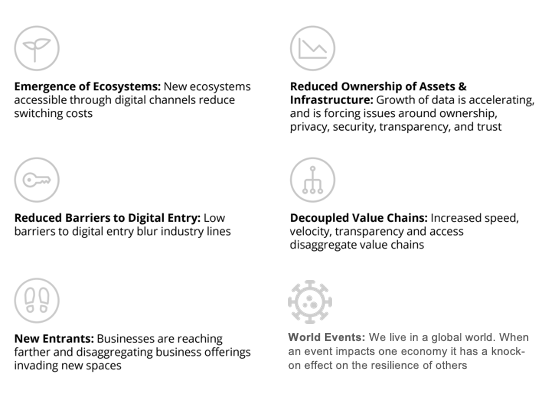
... are good reasons to embrace the digital future sooner rather than later:
Increased profits. Businesses can expect to grow revenues significantly as a result of adopting digital strategies. Digital mastery is an outcome when digital capability and leadership capability are combined; the MIT Center for Digital Business established that a high-performing cohort of organisations who were digital masters outperformed their peers in every industry, by as much as 26%. This increased performance is the result of holistic improvements to organisation, behaviour and technology.
Greater resilience. Disruptive challengers, world events such as Covid-19 and new technologies will continue to shake up customer expectations and processes. A digital business builds resilience by replacing rigid structures and inflexible processes with a workplace culture and infrastructure that can respond and adapt to new demands.
Engaged employees. Disengaged employees cost the economy ££ billions each year. Digital businesses empower employees through transparency, learning opportunities, and open communication. By providing employees with data on how the business is performing – and their part in it – performance improves. Offloading some of the undifferentiated heavy lifting or dull transactional activities to BPO or technology partners means that it's easier for teams to be purposeful. Every one needs autonomy, mastery and purpose.
Avoiding the competency trap. Many companies assume that their current success (and the methods that enable it) will continue indefinitely. Then they end up scrambling to adapt when it stops working, making decisions for short-term survival rather than long-term growth.
Leadership of digital transformation comes from the top — and everywhere else
To be a truly digital organisation, transformation initiatives shouldn’t just come from the top down. Changes in customer expectations, and how the business responds to them, will affect the workloads and working practices of your staff, which means they have to be well positioned to identify risks, suggest solutions, and be empowered to take the initiative.
Any business can be a digital business, whether the transition is incremental or full-on. The term digital refers to speed and agility rather than technology, so don’t leave this to the tech guys.
Digital Transformation is the organisational, behavioural and technology changes needed to re-align around the cross-functional value-chain, so that revenue is secured by iteratively delivering augmented products and services, to ensure that the company stays relevant as the world moves on.
Regardless of the size or scale of your business, activities necessary to turn your company digital can be met with discomfort and uncertainty. Digital leaders need to create the conditions where employees are included as valued collaborators by giving them the strategic insight, data and digital transformation tools they need, and building a culture in which teams feel well-informed, supported and can safely speak up and drive change.
As a leader, you should prepare for these challenges before you start rolling them out …
Leadership is essential to success
Turning your company digital requires investment in appropriate tools and, crucially, investment in leadership.
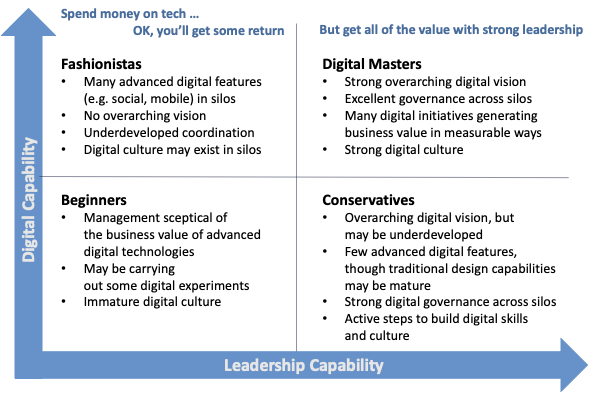
Digital capabilities are the use of technology to change how the company interacts with customers, operates internal processes, or defines its business model.
Leadership capabilities are about creating the necessary conditions required to drive the transformation. These include the transformation vision, the governance model to lead the journey, the necessary information technology and business relationships to produce the results, and engaging employees in the journey.
Preparing for digital success
To turn your company digital, your leaders must …
Provide the vision. Your role as a leader is to stay focused on why the company exists and on implementing its strategy. But make sure that you have digital leaders in your top team. Times of change cause stress and anxiety for everyone; reinforcing the mission and inspiring a sense of purpose can help employees stay motivated.
Share information. Your employees will be more effective if they know what you are trying to achieve and how you are asking them to work. They will be pleased that you have the confidence to do this, and even more pleased if you actively encourage them to take the day-to-day performance of the work under their responsibility and allow them to propose better ways of doing it.
Create a learning culture. Nurturing the people inside your organisation to learn and grow will support your transformation and keep employees engaged and committed. Studies show that most employees need to upgrade their skills annually, but only a minority feel that their development is supported. Changes in technology or consumer preference means that products are often radically different in as short a timespan as 3-5 years. A learning culture is vital to give the workforce the ability to adapt, so that they can keep the value flowing to the end-customer.
Listen. Communication is key, but that doesn’t mean you should be doing all the talking. Make yourself available to employees in every location, to hear what they are working on and what they are worried about.
There are no shortcuts, but digital transformation will make your business more efficient, effective & resilient.
There are different types of transformation activities, each supportive of the other
Don’t worry, turning your company digital is not an inflexible all or nothing activity. We see that there are four different types of digital transformation, each of which moves the company forward, and each of which may be separately progressed:
- Empowering Employees
- Transforming Customer Experience
- Transforming Operational Processes
- Transforming Business Models
You are leaving value on the table if you don’t progress all four types of transformation, but they don’t all have to be done at once, or in any particular order. Each will inform the other.
Ultimately, all activity is focused on providing better service and a better experience for the customer. Delivering value to the customer must be the master aim of the organisation.
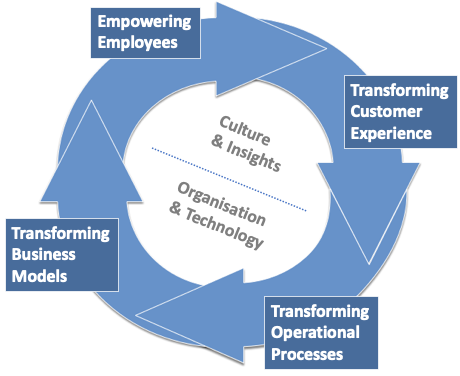
Empowering Employees
In many ways your employees are your company. When you turn your company digital …
Collaboration … every member of the company is meaningfully involved in achieving a shared vision. They understand why the company exists, not just what it does or how it does it. This means working together at different levels of the organisation and across teams to build trust, promote transparency, and engage staff.
Culture … traditional business structures and hierarchies are replaced by decentralised decision making, empowering employees to make decisions and contribute ideas. We’ll see value creation leadership and social leadership emerging alongside the traditional hierarchical organisation structures of ages past.
Tooling … the best tools simplify collaboration and improve productivity. Staff are already using everyday office tools, so a logical first step is to digitally-empower them by bringing all these familiar tools into the cloud, and add apps for real-time collaboration, mobility and knowledge sharing. Stop chasing the master of a document around email and go straight to moving from e-mailing conflicting drafts of documents around, to real-time collaboration of an on-line document via GSuite or M365.
Corporate Memory … no-one is an island, knowledge is shared through collaboration and flexible work practices, and must be easily captured, retained, augmented and found in an intuitive corporate knowledge repository.
Foster collaboration, fuel productivity and maximise mobility to attract and retain top talent, while mitigating risks that come with providing freedom and space to employees.
Transforming Customer Experience
Customers are the lifeblood of the company. You must continually seek new ways to understand who your customers are, what they want and how they perceive the value you offer. When you turn your company digital …
Understand … we build better understanding of what the customer wants/needs by harnessing data representing the fullest view of the customer, through a combination of a dedicated team who are constantly alert to discussions about your brand or products on third-party sites or social networks, and tooling to track, measure and report on every single customer activity and action.
Action … we improve how we explain the perceived value of the product or service to the customer, by drawing actionable intelligence and predictive insights from our 360o view of them or their persona.
Engage ... we then deliver data-driven personalisation at every touchpoint, by being in the same online places and using the same tools as our customers, and drawing on our knowledge of what they like and how they like it. We know enough about someone to deliver value to them at just the right moment, avoiding random broadcast interventions and generic copy. Every optimised experience increases our chance of profit.
Ease … customers expect ease of use and convenience from businesses, which means that our systems of engagement need to be easy and intuitive to use, so that they can interact and buy from us on their terms.
Customers no longer line up meekly at our shop door, impatient to buy what we have to offer. We have to be active where they are active, and try to influence their decision by explaining the value we offer.
Transforming Operational Processes
When you turn your company digital …
Organisation … work is carried out by small self-organising cross-functional product teams, working in short cycles and focused on delivering continual incremental value to customers. This means that Product Owners decide what will be valuable, and work with the rest of the business to see that the value is delivered. We discuss how Lean improves operations in Streamlining Operations.
Funding … these ring-fenced teams are funded by Opex. It no longer makes sense to make investment decisions at the granularity of “projects”; nor to determine success or failure, status or progress, based on Capex funding.
Data-driven … data is collected across a wide, dispersed set of endpoints and insight drawn through advanced analytics to understand their customers and the value they accrue from their products. What’s happening inside the company is also measured. Improvements to both are implemented on a continuous, real-time basis.
Automation & Machine Learning … tedious transactional and repetitive activity is replaced by automated processes, often provided as a cloud-based service. This frees up staff to do revenue generating work or offers management the benefit of headcount efficiency. Machine learning takes this further, in performing specific tasks without using explicit instructions, relying on patterns and inference instead.
Cloud-based … business operational systems and infrastructure are run as elastically scalable, performant, secure and economical cloud-services, allowing businesses to tailor usage to meet their needs, streamline their IT and infrastructure costs and increase resilience. Corporate wiring becomes on-demand and Opex.
Time-honoured organisational structures, funding methods and ways-of-working are no longer relevant.
Transforming Business Models
New players focusing on new consumer behaviours and expectations are changing the game, leveraging digital and technology to disrupt established business models. When you turn your company digital …
Innovation … teams are always experimenting and then learning from the outcomes to inform larger changes across the company. Small teams, small changes and fast feedback loops encourage rapid iteration with easy rollback and no fear of failure. The business needs to keep learning and evolving.
Reinvent … new technology and new thinking redefines products and services. For example, car insurers can now offer products based on tracked mileage and driving habits, rather than an underwriting-led annual premium. Netflix re-invented video distribution. By listening to what the customer wants, reinvention provides compelling outcomes for both the business and its customer, in the same sector.
Sideways … the fundamental building blocks of how value is delivered in the industry are challenged, often blurring industry boundaries. For example, Amazon made their Marketplace technical infrastructure and evolved processes available to others, as Amazon Web Services. AWS now contributes 60% of Amazon’s profits. The Brewdog brewery used their core proficiency to create alcohol-based Hand Sanitiser in bulk in response to Covid-19. By providing what the customer needs – even though they may not realise it yet – digital transformation has led to complementary revenue streams in brand new markets.
To keep up with these digital-first companies, businesses need to adapt not only their technology but also their existing business models and offerings, finding ways to differentiate with new products and services.
Getting started with transformation
You’re ready to start turning your company digital. Let’s start with your staff:
- Leadership. Transformation is an all-company activity, but having a respected leader committed to achieving transformation outcomes is seen as a signal of intent, and significantly increases success.
- Capability Building. Transformation success is more than three times likelier when respondents say their organisations have invested the right amount in digital talent. Developing skills and talent is one of the most important factors for success in a digital change effort, as is redefining individuals’ roles and responsibilities so they align with a transformation’s goals. Success is at least twice as likely when innovative recruitment takes place, using techniques that appeal a candidate’s innate digital conscience.
- Empowering Workers. Digital transformations require cultural and behavioural changes such as calculated risk taking, increased collaboration, and customer centricity. Establishing at least one new way of working, is more likely to result in success, as it is when leaders encourage employees to experiment with new ideas and allow employees to learn from their failures.
- Upgrading Tools. When businesses empower employees to work in new ways digitising tools and processes can support success.
- Communication. As with traditional change initiatives, clear communication is critical during a digital transformation. Communicating the change story is vital – it helps employees understand where the company is headed, why it is changing, and why the changes are important. Engagement messages from leaders and managers help foster a sense of urgency for making the changes within their business units.
Communication is vital to turn your business digital
Digital transformations are just as difficult as traditional change efforts. The battle is already half-won when we have regular and insightful engagement:
- Leadership provide a clear change story for the transformation
- Leadership create a sense of urgency in making the transformation changes
- Managers ensure collaboration between their respective units, so that work is not siloed
- Standard Operating Procedures are updated to include new technologies and evolved processes
- Leadership encourage employees to experiment with new ideas, without sanction if it goes wrong
- People in new roles encourage colleagues to challenge old ways of working
- People in new roles are more involved in developing new ideas than previously
and …
- Digital tools are implemented to make information more accessible
- Digital self-serve tools are implemented for staff and/or business partners, for efficiency and ease of use.
#1 in the list above is a vital contribution
Critical success factors
Becoming customer-centric requires both digital-savvy leaders and a workforce with the capabilities to make a digital transformation’s changes happen. One critical step is to develop clear workforce strategies to help determine the digital skills and capabilities that you have now – and will need—to meet your future goals. Many digitally maturing companies are able to attract new talent based on their use of digital.
You'll need a workforce strategy that will determine digital skills. People analytics is the practice of extracting information from data on your employees to solve business problems. It uses both people data and business data to provide enriched insights into the workforce, how it operates, how much it costs, and how it changes over time. This is more than an HR system and should be populated with your intended target operating model to identify future skills needed.
Turning your company digital requires new ways of working as well as changes to the company culture. Employees must be empowered to work differently and keep up with the faster pace of business. The availability of digital tools and revised processes will support these changes. Since not all leaders will have the experience or desire to support or enact such changes, targeted personal development could help make the necessary shifts in mind-sets and behaviours.
Good communication has always been a key success factor in traditional change efforts, and it is just as important in a digital transformation. You will need a resourced and creative comms team to message about the new, quicker ways of working and the speedier mind-set and behaviour changes that a digital transformation requires. The use of two-way platforms and concise messaging (such as internal social media) will enable open dialogue, much to be preferred to broadcast channels. Good engagement with the workforce makes a successful transformation at least three times more likely.
New skills, new ways of working and abundant communications allow the business to pivot 180o
Stages of maturity
The act of embracing digital transformation isn’t something that is achieved in weeks or months. Turning digital is, instead, a gradual process that involves shifting the way in which your organisation operates as a whole.
Now that you’ve started on the journey to turn your company digital, how do you know where you are and how much further there is to travel? Maturity models are useful in helping make that assessment.
Maturity models have been established in technology-led organisations for over 20 years and have been adapted to cover many endeavours. However, a warning… maturity models are meant to simplify the complexities of reality, but progress is not linear and it doesn’t happen in discrete phases marked by convenient external characteristics.
Reality is always messier than the models allow. But hey - that's why we need models; so that we can abstract and simplify and focus on the big picture and see the trends. Models are like any tool, they can be useful if you use them correctly.
No maturity model will tell you exactly what to do, but we can use them to check if key contextual events have taken place. This is done by people across the organisation answering relevant questions at regular intervals and then by looking at what the answers tell us, and then adjusting our journey as a result of this new insight.
Models are useful in the way that maps are useful... just so long as you don't mistake the map for the terrain.
Organisational characteristics that can tell us our progress in turning digital
Notwithstanding the caveat in the previous section, we can assess progress on culture, insights, organisation and technology.
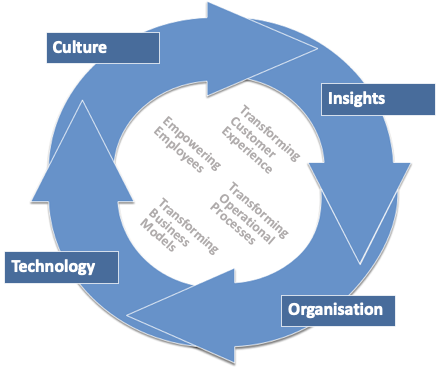
Culture – the business’s approach to digitally driven innovation, and how it empowers employees.
Insights – how well the company uses customer and business data to measure success and inform execution.
Organisation – how aligned the company is to support digital strategy, governance and execution.
Technology – how well the company adopts and uses emerging technology.
How far have we travelled?
Answering a standard set of pertinent questions will give an indication of current stage of maturity, and will inform next steps.
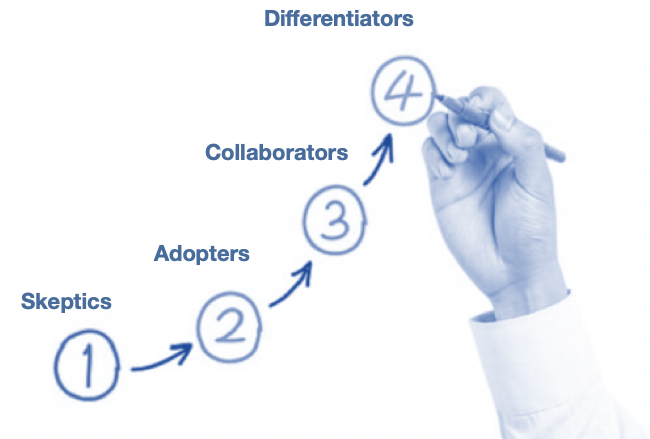
Skeptics – Moving from unconvinced to seeing the reason for digital, and trying some new tools, although vague on the need for cultural change.
Adopters – Understanding the need to become more customer-centric, and prioritising customer relationships higher than production capability, but, whilst investing in skills and infrastructure, since their organisational structure is still reliant on silos, they aren’t able to provide a cohesive experience to their customers (and thus, cannot become customer-centric).
Collaborators – Breaking down silos and beginning to truly focus on a high-quality overall experience for its customers. Shifting towards customer-centricity which allows informed decision making regarding how to continue moving forward as a digitally-mature company.
Differentiator – People within the organisation completely embracing digital concepts - leveraging data to drive customer demand and blend the digital / physical worlds. Process, tech, staff, customers are becoming one super-effective entity, serving todays' market and innovating for tomorrows'.
But… we’re such a legacy organisation, how can we compete?
Traditionally businesses competed with rival companies that looked very much like themselves. Today we are in a world of asymmetric competition, where companies from outside our industry, who look nothing like us, offer competing value to our customers.
Even though digital transformation is so important, there are very few success stories of traditional pre-digital companies growing enough to compete with new companies who have been customer-centric from the start.
To help organisations move up the maturity scale, and turn digital, experts at management consultancy Arthur D Little identified four key questions for organisations to ask themselves when developing digitalisation strategies.
- How can we adapt organisational structures to become more digitally mature?
- How can we ensure company-wide digital governance and investments?
- What are the skills, competencies and roles required for a digital business model?
- What cultural shift is required to build a fundamental advantage over digital competitors?
Analogue-native companies need to make structural changes to their organisational models. Please read on …
How to adapt organisational structures to become more digitally mature
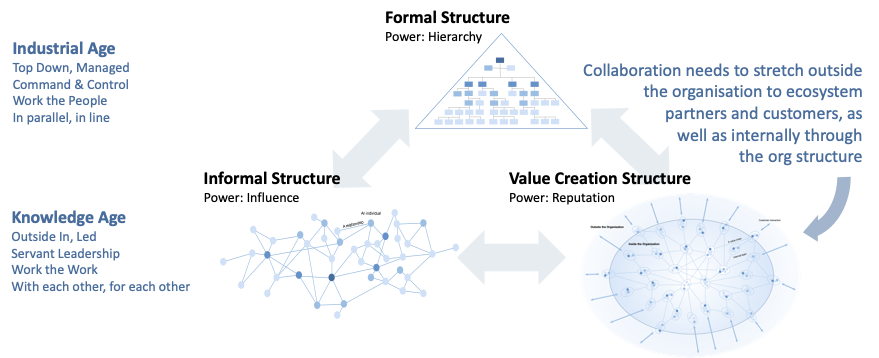
In order to match the agility and customer-centricity of digital players, analogue-native companies need to break down legacy functional silos.
To turn their company digital, leaders must create organisations that foster cross-functional collaboration, with processes, such as product development, that flow seamlessly across departments, enabling the digitalisation of products, processes, and customer touch points in an end-to-end manner.
How to ensure company-wide digital governance and investment
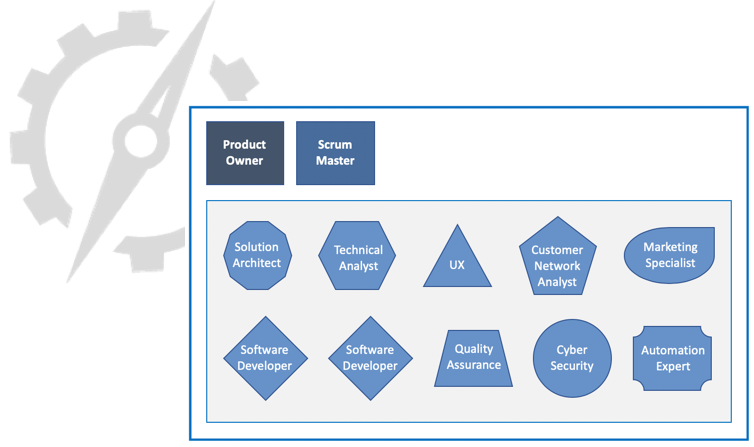
Born-digital companies meld the capabilities of process, product and platform together, across the organisation. Successfully replicating this in an analogue-native organisation starts with making sure that digital investments are shared across the company, both to avoid the cost of duplication but also because the whole business needs to move in the same direction.
Like any major initiative the steering board which oversees the turning your company digital initiative must monitor performance and push to higher levels of maturity. The trick is to balance maintaining the as-is whilst building the to-be.
The big win for analogue-natives to create truly digital operating models, is to stop Capex investment in which individual business units request systems and support from a central IT department.
Instead, as we said earlier in this paper, digital innovation is pushed across all groups by small self-organising cross-functional product teams staffed by a mixture of marketing, product, architecture & engineering SMEs. This sits on top of commodity infrastructure assets.
How to gain the skills, competencies and roles required for a digital business model
Traditional organisations can only deliver their customer-centricity, agility and culture of continuous experimentation when they are competently and inspirationally led, and staff embrace the new working methods.
Analogue-native firms have typically attracted people with specific industry and functional specialisations, and therefore have gaps in their digital skills and competencies.
The success of turning your company digital must therefore rely on developing or acquiring specific digital competencies. It also demands a change in behaviours to create the culture necessary in a digital organisation.
Analogue-native companies should aim to develop new leadership roles focused on the transformation of traditional operations using digital processes. New leadership should aim to generate new business opportunities, revenue streams and customer services from the adoption of digital technologies.
Whatever we call our digital leader …
- the availability of data,
- the power and availability of technology,
- the rise of mobile and cloud computing, artificial intelligence and 5G
- customers’ raised expectations and the need to see value, and a
- shift to more agile ways of working
... demand that we rethink how technology serves the organisation.
The cultural shift required to build a fundamental advantage over digital competitors
Analogue companies have often succeeded through creating systems and structures to control complicated tasks.
While the technology to enable the digital shift is often already in place, ways of working and thinking within the organisation need to be challenged so that operational culture can change too.
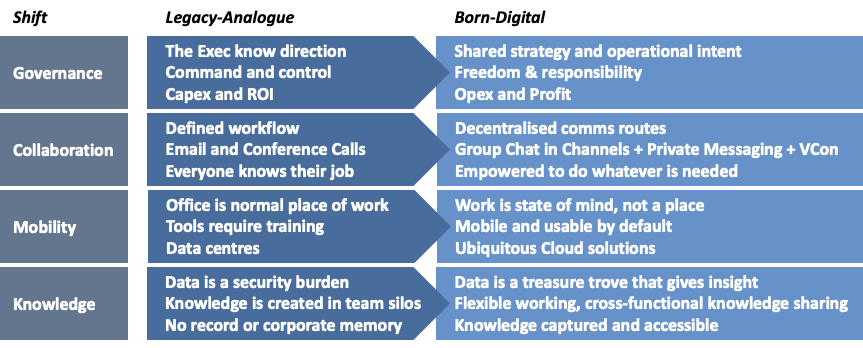
So… what’s next?
Digital transformation is an imperative for all businesses, from the small to the enterprise.
Some leaders may feel that the very term ‘digital transformation’ has become so widely used and with such broad commentary on what it is and what to do about it that its no longer helpful.
You may not love the term. But commercial mandates behind the expression – to rethink old operating models, to experiment more, to become more agile in your ability to respond to customers and rivals – aren't going anywhere.
Digital Transformation is the organisational, behavioural and technology changes needed to re-align around the cross-functional value-chain, so that revenue is secured by iteratively delivering augmented products and services, to ensure that the company stays relevant as the world moves on.
To turn your company digital you need to:
- Integrate digital technology into all areas of your business
- Lead on cultural change which empowers employees to make decisions and contribute ideas
- Provide strong leadership.
So that you can put the customer and the value you give them at the very heart of what you do.
This will result in
- Increased profits
- Greater resilience
- Happier employees.
and, of course, staying relevant, and in business.
